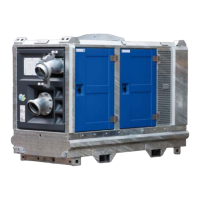BA series pumps
1401 Pump unit with diesel drive
8.41
• Biodiesel has poor oxidation stability, which can result in long term problems in the storage of
biodiesel. The poor oxidation stability may accelerate fuel oxidation in the fuel system. This is
especially true in engines with electronic fuel systems because these engines operate at higher
temperatures. Consult the fuel supplier for oxidation stability additives.
• Biodiesel is a fuel that can be made from a variety of feedstock. The feedstock that is used can
affect the performance of the product. Two of the characteristics of the fuel that are affected are
cold flow and oxidation stability. Contact your fuel supplier for guidance.
• Biodiesel or biodiesel blends are not recommended for engines that will operate occasionally. This
is due to poor oxidation stability. If the user is prepared to accept some risk, then limit biodiesel to a
maximum of B5. Examples of applications that should limit the use of biodiesel are the following:
Standby Generator sets and certain emergency vehicles
• Biodiesel is an excellent medium for microbial contamination and growth. Microbial contamination
and growth can cause corrosion in the fuel system and premature plugging of the fuel filter. The use
of conventionalanti-microbial additives and the effectiveness of conventional anti-microbial
additives in biodiesel is not known. Consult your supplier of fuel and additive for assistance.
• Care must be taken in order to remove water from fuel tanks. Water accelerates microbial
contamination and growth. When biodiesel is compared to distillate fuels, water is naturally more
likely to exist in the biodiesel.
Fuel for Cold Weather Operation
The European standard “EN590” contains climate dependant requirements and a range of options.
The options can be applied differently in each country.
There are 5 classes that are given to arctic climates and severe winter climates. 0, 1, 2, 3, and 4.
Fuel that complies with “EN590” CLASS 4 can be used at temperatures as low as -44 °C
(-47.2 °F). Refer to “EN590” for a detailed discretion of the physical properties of the fuel.
The diesel fuel “ASTM D975 Grade 1-D S15 or S500” that is used in the united states of america may
be used in very cold temperatures that are below -18 °C (-0.4 °F).
In extreme cold ambient conditions, you may also use fuels that are listed in the table E. These fuels
are intended to be used in temperatures that can be as low as -54 °C
(-65.2°F).
(1) The use of these fuels is acceptable with an appropriate fuel additive and the fuels must meet minimum requirements
that are stated in Tables B, C and D. Fuel samples should be analyzed for the compliance. Fuels MUST NOT exceed
0.46 mm lubricity wear scar diameter that is tested on a HFFR . The test must be performed at 60 °C. Refer to “ISO
12156-1 ”. Fuels must have minimum viscosity of 1.4 centistokes that is delivered to the fuel injection pump. Fuel cooling
may be required in order to maintain minimum viscosity of 1.4 centistokes that is delivered to the fuel injection pump.
Light Distillate Fuels
(1)
Specification Grade
"MIL-DTL-5624U "JP-5
"MIL-DTL-83133E "JP-8
"ASTM D1655 "Jet-A-1

